Project Execution Quality and Control: A Comprehensive Report
VerifiedAdded on 2020/04/01
|9
|2797
|65
Report
AI Summary
This report offers an in-depth exploration of quality management and control within projects. It begins by outlining the key components of a project quality management plan, encompassing quality definition, planning, assurance, and control, emphasizing the use of tools like benchmarking and control charts. The report then transitions to address critical aspects of global projects, including cultural awareness, training, and legal considerations. It highlights challenges such as language barriers, personality differences, and varying work ethics, along with the significance of adapting human resource management policies to suit multicultural environments. Furthermore, the report examines the impact of legal and regulatory differences across countries, emphasizing the need for careful study of administrative frameworks, quality standards, and legal clauses in contracts. The report concludes by underscoring the importance of quality control processes in mitigating these challenges and ensuring successful project outcomes in an international context.
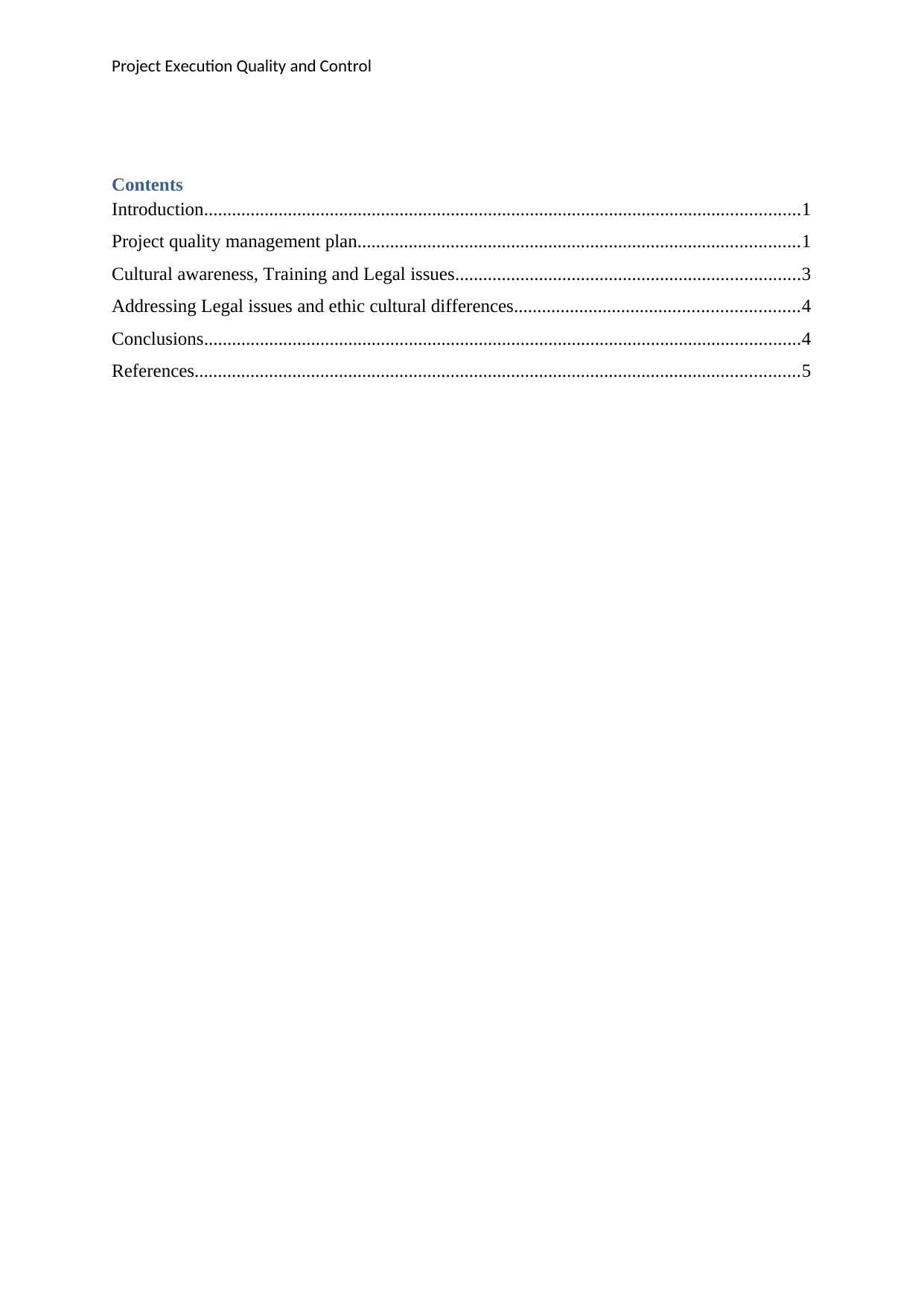
Project Execution Quality and Control
Contents
Introduction................................................................................................................................1
Project quality management plan...............................................................................................1
Cultural awareness, Training and Legal issues..........................................................................3
Addressing Legal issues and ethic cultural differences.............................................................4
Conclusions................................................................................................................................4
References..................................................................................................................................5
Contents
Introduction................................................................................................................................1
Project quality management plan...............................................................................................1
Cultural awareness, Training and Legal issues..........................................................................3
Addressing Legal issues and ethic cultural differences.............................................................4
Conclusions................................................................................................................................4
References..................................................................................................................................5
Paraphrase This Document
Need a fresh take? Get an instant paraphrase of this document with our AI Paraphraser
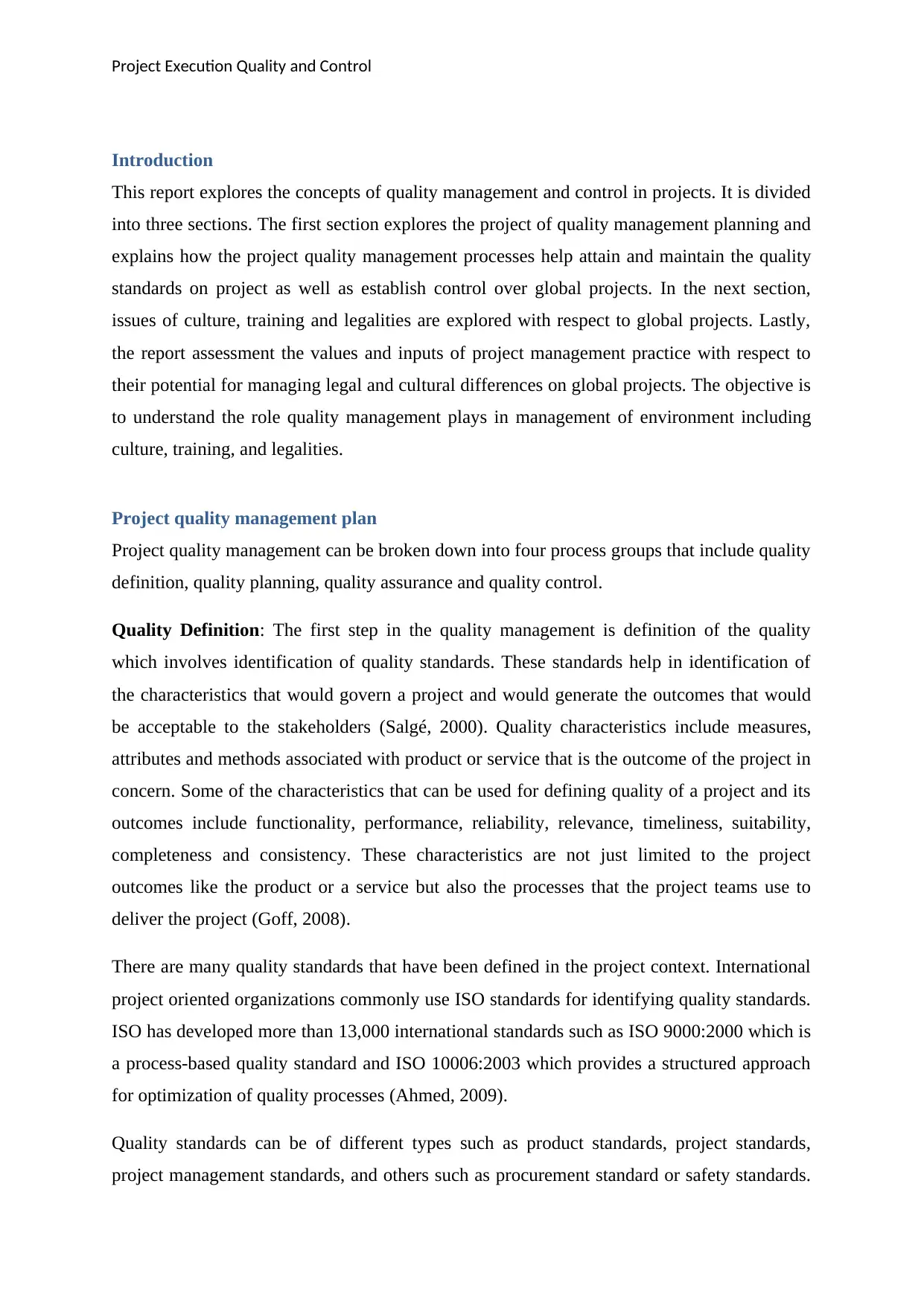
Project Execution Quality and Control
Introduction
This report explores the concepts of quality management and control in projects. It is divided
into three sections. The first section explores the project of quality management planning and
explains how the project quality management processes help attain and maintain the quality
standards on project as well as establish control over global projects. In the next section,
issues of culture, training and legalities are explored with respect to global projects. Lastly,
the report assessment the values and inputs of project management practice with respect to
their potential for managing legal and cultural differences on global projects. The objective is
to understand the role quality management plays in management of environment including
culture, training, and legalities.
Project quality management plan
Project quality management can be broken down into four process groups that include quality
definition, quality planning, quality assurance and quality control.
Quality Definition: The first step in the quality management is definition of the quality
which involves identification of quality standards. These standards help in identification of
the characteristics that would govern a project and would generate the outcomes that would
be acceptable to the stakeholders (Salgé, 2000). Quality characteristics include measures,
attributes and methods associated with product or service that is the outcome of the project in
concern. Some of the characteristics that can be used for defining quality of a project and its
outcomes include functionality, performance, reliability, relevance, timeliness, suitability,
completeness and consistency. These characteristics are not just limited to the project
outcomes like the product or a service but also the processes that the project teams use to
deliver the project (Goff, 2008).
There are many quality standards that have been defined in the project context. International
project oriented organizations commonly use ISO standards for identifying quality standards.
ISO has developed more than 13,000 international standards such as ISO 9000:2000 which is
a process-based quality standard and ISO 10006:2003 which provides a structured approach
for optimization of quality processes (Ahmed, 2009).
Quality standards can be of different types such as product standards, project standards,
project management standards, and others such as procurement standard or safety standards.
Introduction
This report explores the concepts of quality management and control in projects. It is divided
into three sections. The first section explores the project of quality management planning and
explains how the project quality management processes help attain and maintain the quality
standards on project as well as establish control over global projects. In the next section,
issues of culture, training and legalities are explored with respect to global projects. Lastly,
the report assessment the values and inputs of project management practice with respect to
their potential for managing legal and cultural differences on global projects. The objective is
to understand the role quality management plays in management of environment including
culture, training, and legalities.
Project quality management plan
Project quality management can be broken down into four process groups that include quality
definition, quality planning, quality assurance and quality control.
Quality Definition: The first step in the quality management is definition of the quality
which involves identification of quality standards. These standards help in identification of
the characteristics that would govern a project and would generate the outcomes that would
be acceptable to the stakeholders (Salgé, 2000). Quality characteristics include measures,
attributes and methods associated with product or service that is the outcome of the project in
concern. Some of the characteristics that can be used for defining quality of a project and its
outcomes include functionality, performance, reliability, relevance, timeliness, suitability,
completeness and consistency. These characteristics are not just limited to the project
outcomes like the product or a service but also the processes that the project teams use to
deliver the project (Goff, 2008).
There are many quality standards that have been defined in the project context. International
project oriented organizations commonly use ISO standards for identifying quality standards.
ISO has developed more than 13,000 international standards such as ISO 9000:2000 which is
a process-based quality standard and ISO 10006:2003 which provides a structured approach
for optimization of quality processes (Ahmed, 2009).
Quality standards can be of different types such as product standards, project standards,
project management standards, and others such as procurement standard or safety standards.
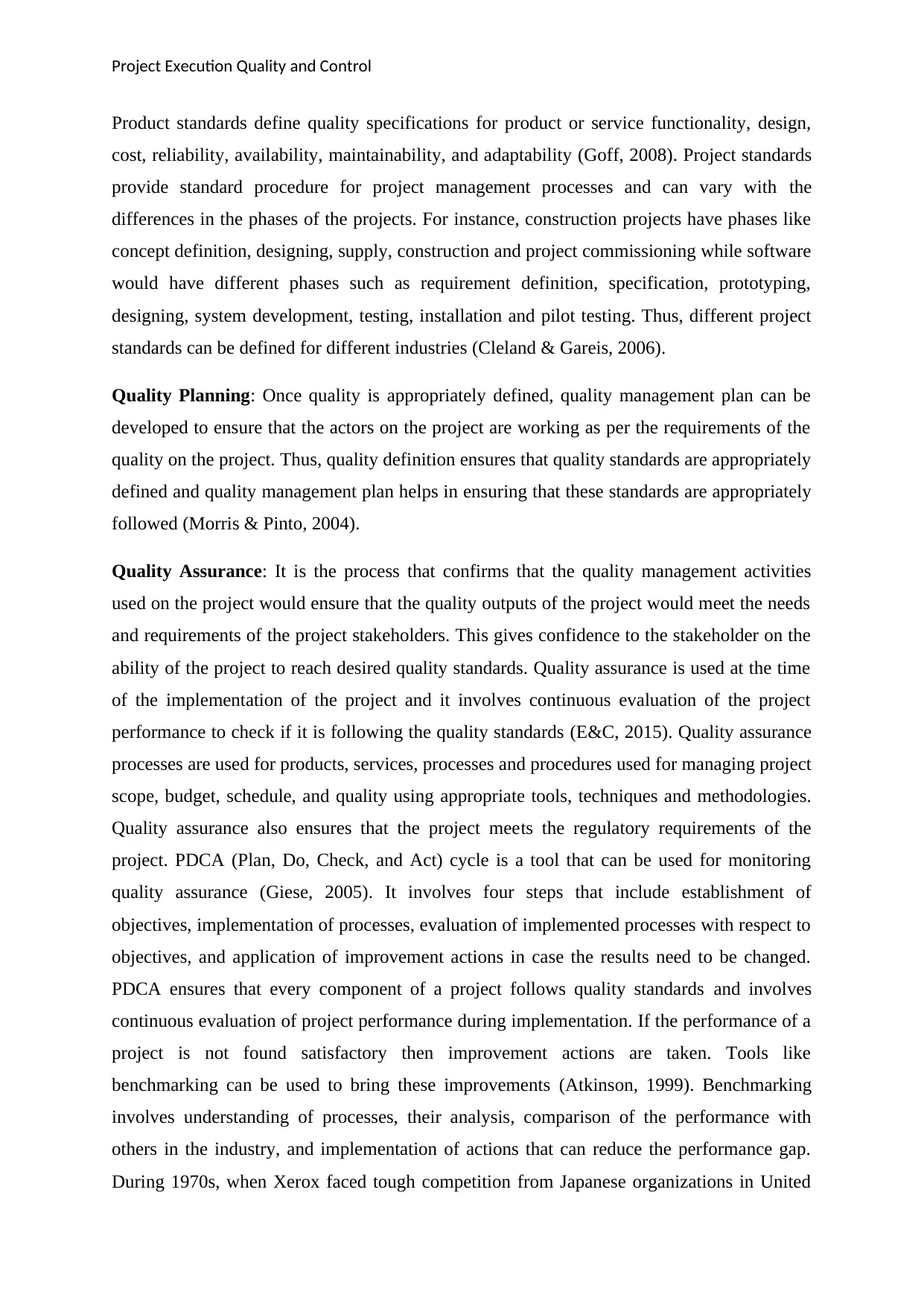
Project Execution Quality and Control
Product standards define quality specifications for product or service functionality, design,
cost, reliability, availability, maintainability, and adaptability (Goff, 2008). Project standards
provide standard procedure for project management processes and can vary with the
differences in the phases of the projects. For instance, construction projects have phases like
concept definition, designing, supply, construction and project commissioning while software
would have different phases such as requirement definition, specification, prototyping,
designing, system development, testing, installation and pilot testing. Thus, different project
standards can be defined for different industries (Cleland & Gareis, 2006).
Quality Planning: Once quality is appropriately defined, quality management plan can be
developed to ensure that the actors on the project are working as per the requirements of the
quality on the project. Thus, quality definition ensures that quality standards are appropriately
defined and quality management plan helps in ensuring that these standards are appropriately
followed (Morris & Pinto, 2004).
Quality Assurance: It is the process that confirms that the quality management activities
used on the project would ensure that the quality outputs of the project would meet the needs
and requirements of the project stakeholders. This gives confidence to the stakeholder on the
ability of the project to reach desired quality standards. Quality assurance is used at the time
of the implementation of the project and it involves continuous evaluation of the project
performance to check if it is following the quality standards (E&C, 2015). Quality assurance
processes are used for products, services, processes and procedures used for managing project
scope, budget, schedule, and quality using appropriate tools, techniques and methodologies.
Quality assurance also ensures that the project meets the regulatory requirements of the
project. PDCA (Plan, Do, Check, and Act) cycle is a tool that can be used for monitoring
quality assurance (Giese, 2005). It involves four steps that include establishment of
objectives, implementation of processes, evaluation of implemented processes with respect to
objectives, and application of improvement actions in case the results need to be changed.
PDCA ensures that every component of a project follows quality standards and involves
continuous evaluation of project performance during implementation. If the performance of a
project is not found satisfactory then improvement actions are taken. Tools like
benchmarking can be used to bring these improvements (Atkinson, 1999). Benchmarking
involves understanding of processes, their analysis, comparison of the performance with
others in the industry, and implementation of actions that can reduce the performance gap.
During 1970s, when Xerox faced tough competition from Japanese organizations in United
Product standards define quality specifications for product or service functionality, design,
cost, reliability, availability, maintainability, and adaptability (Goff, 2008). Project standards
provide standard procedure for project management processes and can vary with the
differences in the phases of the projects. For instance, construction projects have phases like
concept definition, designing, supply, construction and project commissioning while software
would have different phases such as requirement definition, specification, prototyping,
designing, system development, testing, installation and pilot testing. Thus, different project
standards can be defined for different industries (Cleland & Gareis, 2006).
Quality Planning: Once quality is appropriately defined, quality management plan can be
developed to ensure that the actors on the project are working as per the requirements of the
quality on the project. Thus, quality definition ensures that quality standards are appropriately
defined and quality management plan helps in ensuring that these standards are appropriately
followed (Morris & Pinto, 2004).
Quality Assurance: It is the process that confirms that the quality management activities
used on the project would ensure that the quality outputs of the project would meet the needs
and requirements of the project stakeholders. This gives confidence to the stakeholder on the
ability of the project to reach desired quality standards. Quality assurance is used at the time
of the implementation of the project and it involves continuous evaluation of the project
performance to check if it is following the quality standards (E&C, 2015). Quality assurance
processes are used for products, services, processes and procedures used for managing project
scope, budget, schedule, and quality using appropriate tools, techniques and methodologies.
Quality assurance also ensures that the project meets the regulatory requirements of the
project. PDCA (Plan, Do, Check, and Act) cycle is a tool that can be used for monitoring
quality assurance (Giese, 2005). It involves four steps that include establishment of
objectives, implementation of processes, evaluation of implemented processes with respect to
objectives, and application of improvement actions in case the results need to be changed.
PDCA ensures that every component of a project follows quality standards and involves
continuous evaluation of project performance during implementation. If the performance of a
project is not found satisfactory then improvement actions are taken. Tools like
benchmarking can be used to bring these improvements (Atkinson, 1999). Benchmarking
involves understanding of processes, their analysis, comparison of the performance with
others in the industry, and implementation of actions that can reduce the performance gap.
During 1970s, when Xerox faced tough competition from Japanese organizations in United
⊘ This is a preview!⊘
Do you want full access?
Subscribe today to unlock all pages.

Trusted by 1+ million students worldwide
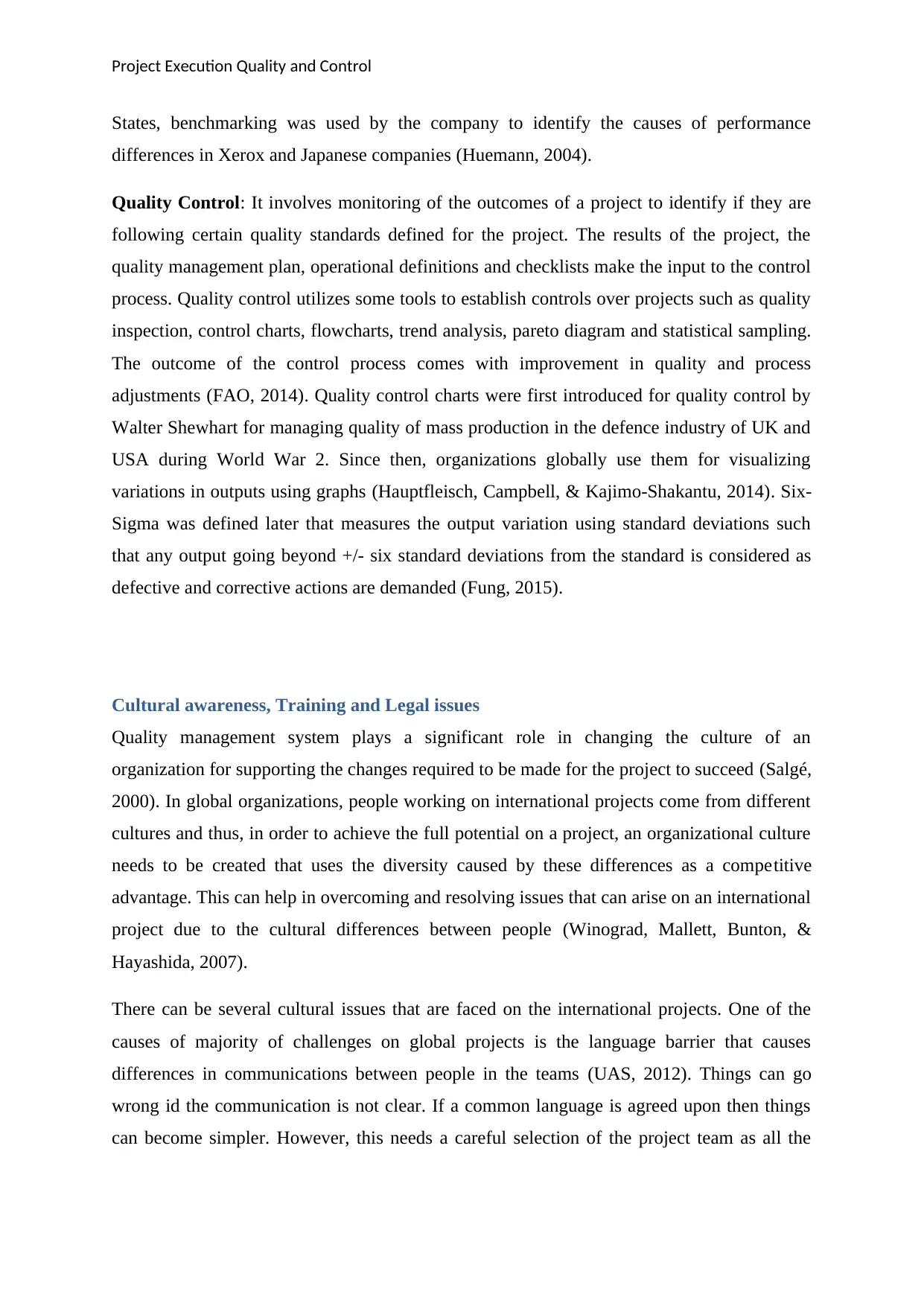
Project Execution Quality and Control
States, benchmarking was used by the company to identify the causes of performance
differences in Xerox and Japanese companies (Huemann, 2004).
Quality Control: It involves monitoring of the outcomes of a project to identify if they are
following certain quality standards defined for the project. The results of the project, the
quality management plan, operational definitions and checklists make the input to the control
process. Quality control utilizes some tools to establish controls over projects such as quality
inspection, control charts, flowcharts, trend analysis, pareto diagram and statistical sampling.
The outcome of the control process comes with improvement in quality and process
adjustments (FAO, 2014). Quality control charts were first introduced for quality control by
Walter Shewhart for managing quality of mass production in the defence industry of UK and
USA during World War 2. Since then, organizations globally use them for visualizing
variations in outputs using graphs (Hauptfleisch, Campbell, & Kajimo-Shakantu, 2014). Six-
Sigma was defined later that measures the output variation using standard deviations such
that any output going beyond +/- six standard deviations from the standard is considered as
defective and corrective actions are demanded (Fung, 2015).
Cultural awareness, Training and Legal issues
Quality management system plays a significant role in changing the culture of an
organization for supporting the changes required to be made for the project to succeed (Salgé,
2000). In global organizations, people working on international projects come from different
cultures and thus, in order to achieve the full potential on a project, an organizational culture
needs to be created that uses the diversity caused by these differences as a competitive
advantage. This can help in overcoming and resolving issues that can arise on an international
project due to the cultural differences between people (Winograd, Mallett, Bunton, &
Hayashida, 2007).
There can be several cultural issues that are faced on the international projects. One of the
causes of majority of challenges on global projects is the language barrier that causes
differences in communications between people in the teams (UAS, 2012). Things can go
wrong id the communication is not clear. If a common language is agreed upon then things
can become simpler. However, this needs a careful selection of the project team as all the
States, benchmarking was used by the company to identify the causes of performance
differences in Xerox and Japanese companies (Huemann, 2004).
Quality Control: It involves monitoring of the outcomes of a project to identify if they are
following certain quality standards defined for the project. The results of the project, the
quality management plan, operational definitions and checklists make the input to the control
process. Quality control utilizes some tools to establish controls over projects such as quality
inspection, control charts, flowcharts, trend analysis, pareto diagram and statistical sampling.
The outcome of the control process comes with improvement in quality and process
adjustments (FAO, 2014). Quality control charts were first introduced for quality control by
Walter Shewhart for managing quality of mass production in the defence industry of UK and
USA during World War 2. Since then, organizations globally use them for visualizing
variations in outputs using graphs (Hauptfleisch, Campbell, & Kajimo-Shakantu, 2014). Six-
Sigma was defined later that measures the output variation using standard deviations such
that any output going beyond +/- six standard deviations from the standard is considered as
defective and corrective actions are demanded (Fung, 2015).
Cultural awareness, Training and Legal issues
Quality management system plays a significant role in changing the culture of an
organization for supporting the changes required to be made for the project to succeed (Salgé,
2000). In global organizations, people working on international projects come from different
cultures and thus, in order to achieve the full potential on a project, an organizational culture
needs to be created that uses the diversity caused by these differences as a competitive
advantage. This can help in overcoming and resolving issues that can arise on an international
project due to the cultural differences between people (Winograd, Mallett, Bunton, &
Hayashida, 2007).
There can be several cultural issues that are faced on the international projects. One of the
causes of majority of challenges on global projects is the language barrier that causes
differences in communications between people in the teams (UAS, 2012). Things can go
wrong id the communication is not clear. If a common language is agreed upon then things
can become simpler. However, this needs a careful selection of the project team as all the
Paraphrase This Document
Need a fresh take? Get an instant paraphrase of this document with our AI Paraphraser
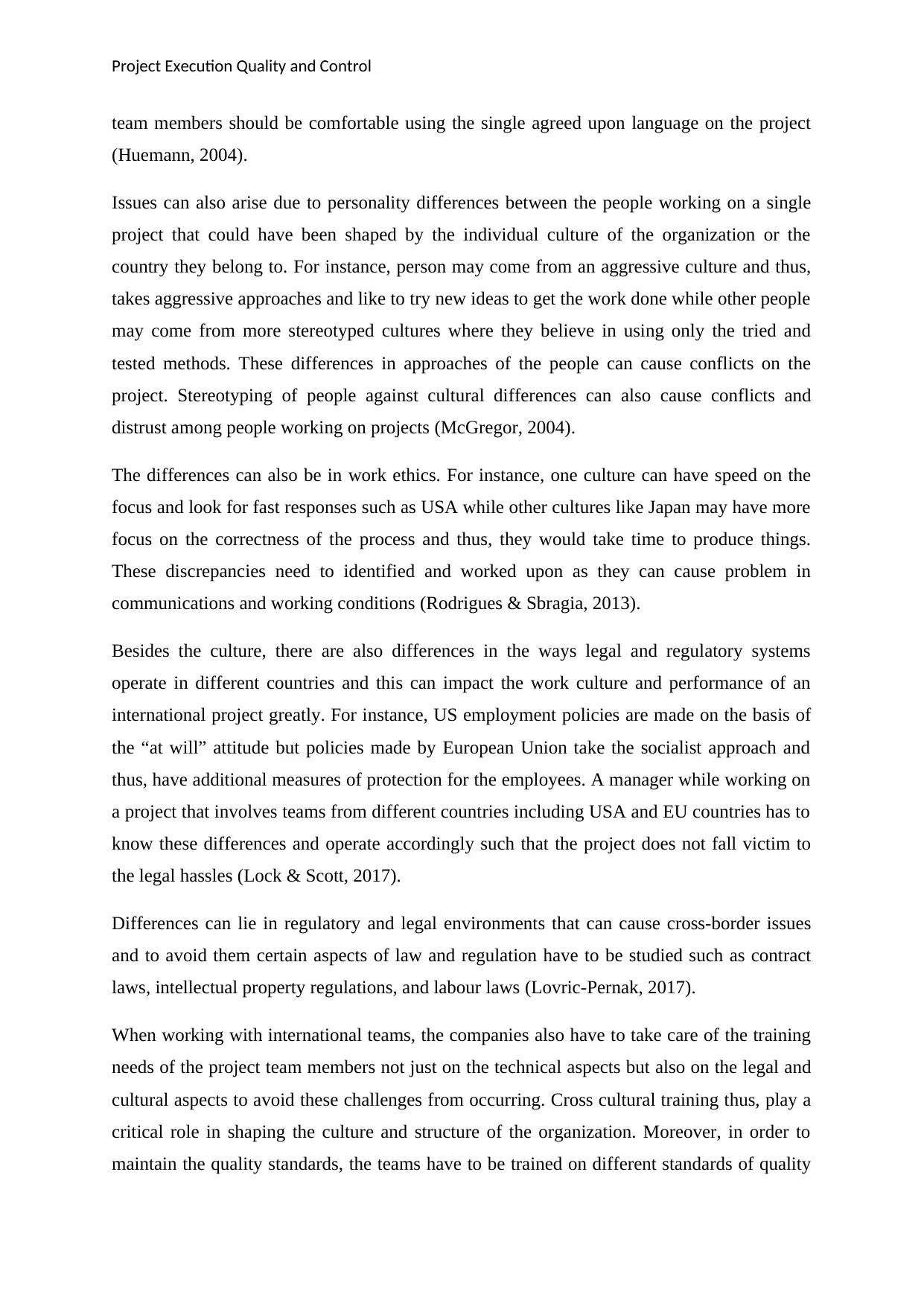
Project Execution Quality and Control
team members should be comfortable using the single agreed upon language on the project
(Huemann, 2004).
Issues can also arise due to personality differences between the people working on a single
project that could have been shaped by the individual culture of the organization or the
country they belong to. For instance, person may come from an aggressive culture and thus,
takes aggressive approaches and like to try new ideas to get the work done while other people
may come from more stereotyped cultures where they believe in using only the tried and
tested methods. These differences in approaches of the people can cause conflicts on the
project. Stereotyping of people against cultural differences can also cause conflicts and
distrust among people working on projects (McGregor, 2004).
The differences can also be in work ethics. For instance, one culture can have speed on the
focus and look for fast responses such as USA while other cultures like Japan may have more
focus on the correctness of the process and thus, they would take time to produce things.
These discrepancies need to identified and worked upon as they can cause problem in
communications and working conditions (Rodrigues & Sbragia, 2013).
Besides the culture, there are also differences in the ways legal and regulatory systems
operate in different countries and this can impact the work culture and performance of an
international project greatly. For instance, US employment policies are made on the basis of
the “at will” attitude but policies made by European Union take the socialist approach and
thus, have additional measures of protection for the employees. A manager while working on
a project that involves teams from different countries including USA and EU countries has to
know these differences and operate accordingly such that the project does not fall victim to
the legal hassles (Lock & Scott, 2017).
Differences can lie in regulatory and legal environments that can cause cross-border issues
and to avoid them certain aspects of law and regulation have to be studied such as contract
laws, intellectual property regulations, and labour laws (Lovric-Pernak, 2017).
When working with international teams, the companies also have to take care of the training
needs of the project team members not just on the technical aspects but also on the legal and
cultural aspects to avoid these challenges from occurring. Cross cultural training thus, play a
critical role in shaping the culture and structure of the organization. Moreover, in order to
maintain the quality standards, the teams have to be trained on different standards of quality
team members should be comfortable using the single agreed upon language on the project
(Huemann, 2004).
Issues can also arise due to personality differences between the people working on a single
project that could have been shaped by the individual culture of the organization or the
country they belong to. For instance, person may come from an aggressive culture and thus,
takes aggressive approaches and like to try new ideas to get the work done while other people
may come from more stereotyped cultures where they believe in using only the tried and
tested methods. These differences in approaches of the people can cause conflicts on the
project. Stereotyping of people against cultural differences can also cause conflicts and
distrust among people working on projects (McGregor, 2004).
The differences can also be in work ethics. For instance, one culture can have speed on the
focus and look for fast responses such as USA while other cultures like Japan may have more
focus on the correctness of the process and thus, they would take time to produce things.
These discrepancies need to identified and worked upon as they can cause problem in
communications and working conditions (Rodrigues & Sbragia, 2013).
Besides the culture, there are also differences in the ways legal and regulatory systems
operate in different countries and this can impact the work culture and performance of an
international project greatly. For instance, US employment policies are made on the basis of
the “at will” attitude but policies made by European Union take the socialist approach and
thus, have additional measures of protection for the employees. A manager while working on
a project that involves teams from different countries including USA and EU countries has to
know these differences and operate accordingly such that the project does not fall victim to
the legal hassles (Lock & Scott, 2017).
Differences can lie in regulatory and legal environments that can cause cross-border issues
and to avoid them certain aspects of law and regulation have to be studied such as contract
laws, intellectual property regulations, and labour laws (Lovric-Pernak, 2017).
When working with international teams, the companies also have to take care of the training
needs of the project team members not just on the technical aspects but also on the legal and
cultural aspects to avoid these challenges from occurring. Cross cultural training thus, play a
critical role in shaping the culture and structure of the organization. Moreover, in order to
maintain the quality standards, the teams have to be trained on different standards of quality
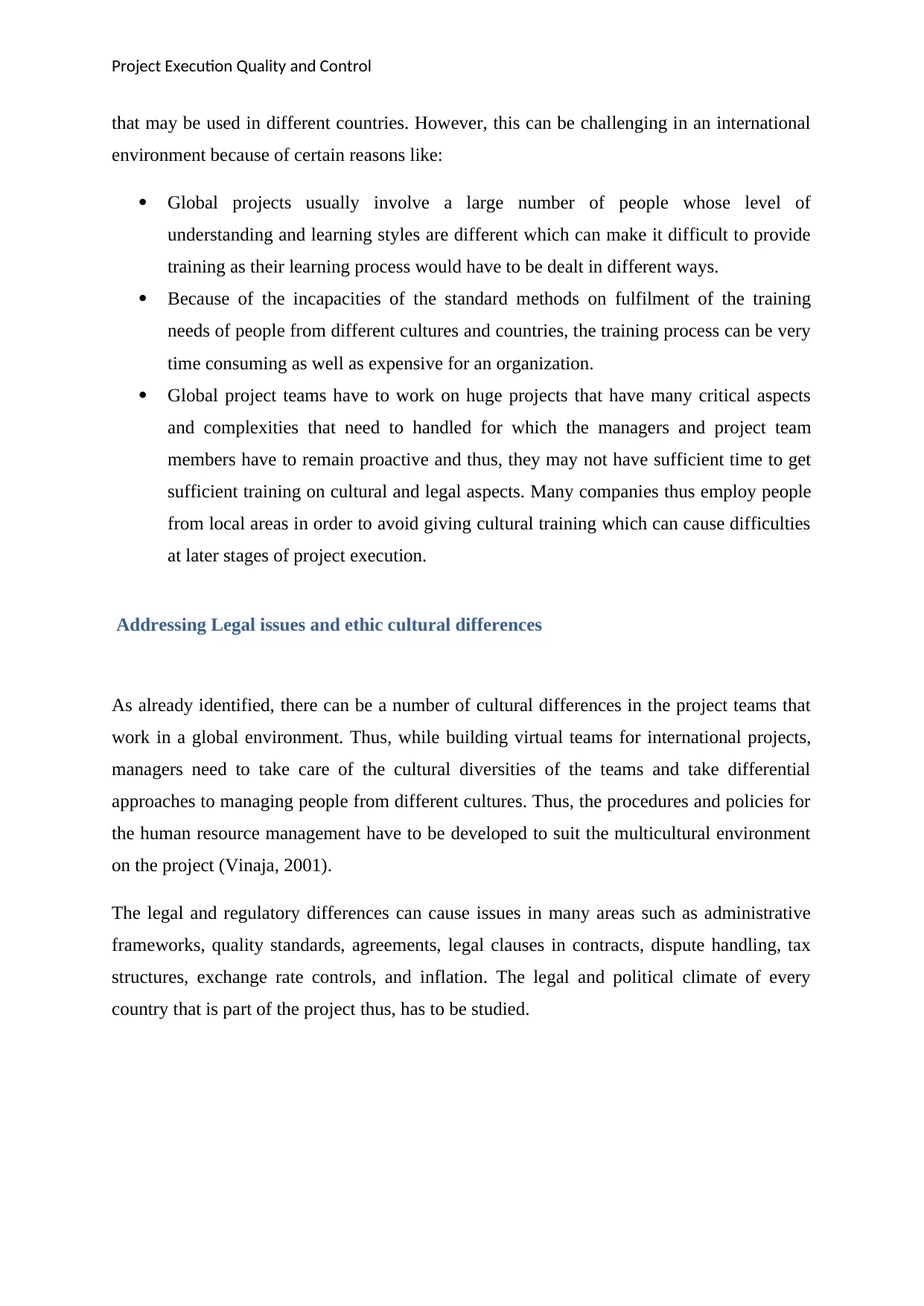
Project Execution Quality and Control
that may be used in different countries. However, this can be challenging in an international
environment because of certain reasons like:
Global projects usually involve a large number of people whose level of
understanding and learning styles are different which can make it difficult to provide
training as their learning process would have to be dealt in different ways.
Because of the incapacities of the standard methods on fulfilment of the training
needs of people from different cultures and countries, the training process can be very
time consuming as well as expensive for an organization.
Global project teams have to work on huge projects that have many critical aspects
and complexities that need to handled for which the managers and project team
members have to remain proactive and thus, they may not have sufficient time to get
sufficient training on cultural and legal aspects. Many companies thus employ people
from local areas in order to avoid giving cultural training which can cause difficulties
at later stages of project execution.
Addressing Legal issues and ethic cultural differences
As already identified, there can be a number of cultural differences in the project teams that
work in a global environment. Thus, while building virtual teams for international projects,
managers need to take care of the cultural diversities of the teams and take differential
approaches to managing people from different cultures. Thus, the procedures and policies for
the human resource management have to be developed to suit the multicultural environment
on the project (Vinaja, 2001).
The legal and regulatory differences can cause issues in many areas such as administrative
frameworks, quality standards, agreements, legal clauses in contracts, dispute handling, tax
structures, exchange rate controls, and inflation. The legal and political climate of every
country that is part of the project thus, has to be studied.
that may be used in different countries. However, this can be challenging in an international
environment because of certain reasons like:
Global projects usually involve a large number of people whose level of
understanding and learning styles are different which can make it difficult to provide
training as their learning process would have to be dealt in different ways.
Because of the incapacities of the standard methods on fulfilment of the training
needs of people from different cultures and countries, the training process can be very
time consuming as well as expensive for an organization.
Global project teams have to work on huge projects that have many critical aspects
and complexities that need to handled for which the managers and project team
members have to remain proactive and thus, they may not have sufficient time to get
sufficient training on cultural and legal aspects. Many companies thus employ people
from local areas in order to avoid giving cultural training which can cause difficulties
at later stages of project execution.
Addressing Legal issues and ethic cultural differences
As already identified, there can be a number of cultural differences in the project teams that
work in a global environment. Thus, while building virtual teams for international projects,
managers need to take care of the cultural diversities of the teams and take differential
approaches to managing people from different cultures. Thus, the procedures and policies for
the human resource management have to be developed to suit the multicultural environment
on the project (Vinaja, 2001).
The legal and regulatory differences can cause issues in many areas such as administrative
frameworks, quality standards, agreements, legal clauses in contracts, dispute handling, tax
structures, exchange rate controls, and inflation. The legal and political climate of every
country that is part of the project thus, has to be studied.
⊘ This is a preview!⊘
Do you want full access?
Subscribe today to unlock all pages.

Trusted by 1+ million students worldwide
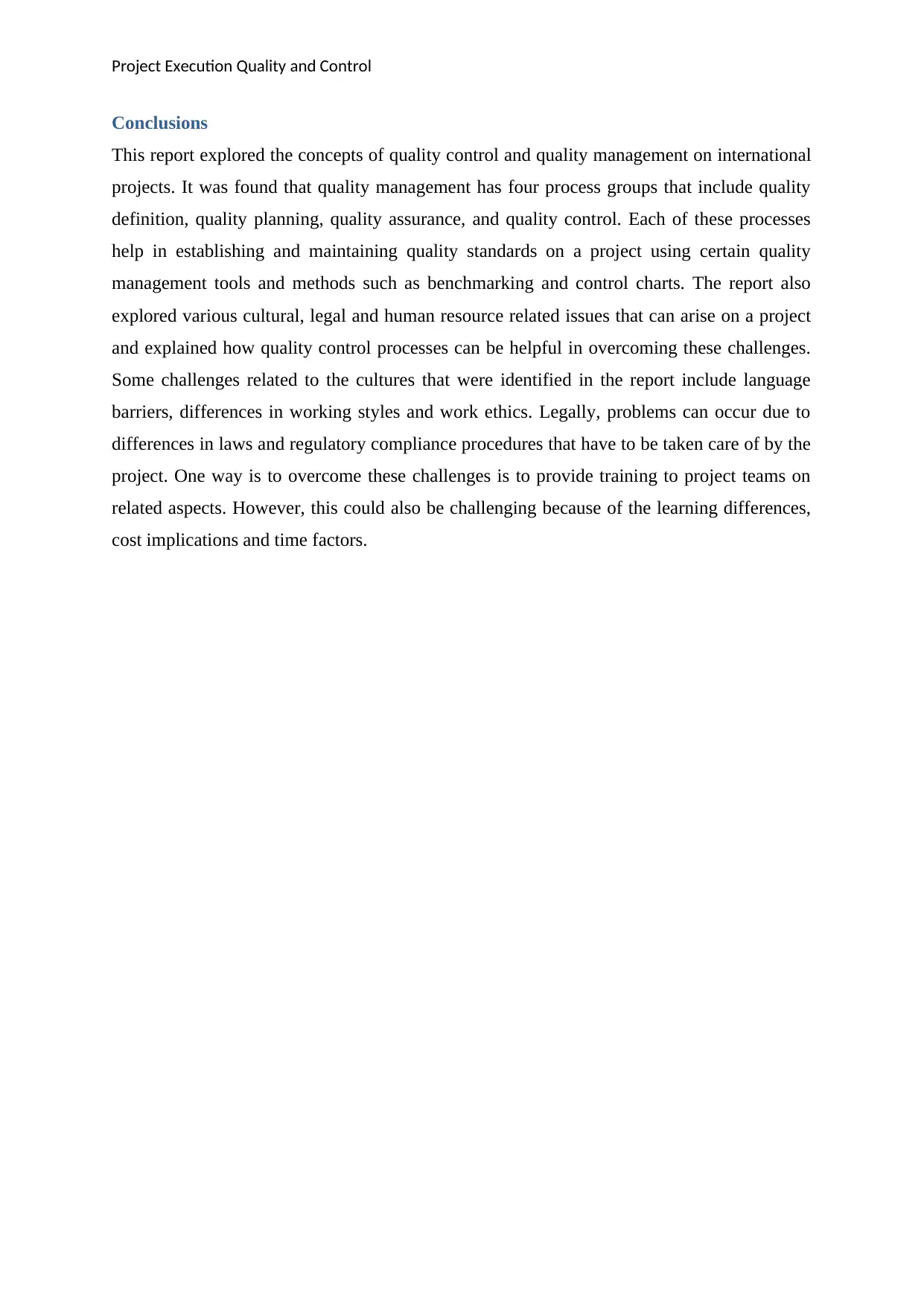
Project Execution Quality and Control
Conclusions
This report explored the concepts of quality control and quality management on international
projects. It was found that quality management has four process groups that include quality
definition, quality planning, quality assurance, and quality control. Each of these processes
help in establishing and maintaining quality standards on a project using certain quality
management tools and methods such as benchmarking and control charts. The report also
explored various cultural, legal and human resource related issues that can arise on a project
and explained how quality control processes can be helpful in overcoming these challenges.
Some challenges related to the cultures that were identified in the report include language
barriers, differences in working styles and work ethics. Legally, problems can occur due to
differences in laws and regulatory compliance procedures that have to be taken care of by the
project. One way is to overcome these challenges is to provide training to project teams on
related aspects. However, this could also be challenging because of the learning differences,
cost implications and time factors.
Conclusions
This report explored the concepts of quality control and quality management on international
projects. It was found that quality management has four process groups that include quality
definition, quality planning, quality assurance, and quality control. Each of these processes
help in establishing and maintaining quality standards on a project using certain quality
management tools and methods such as benchmarking and control charts. The report also
explored various cultural, legal and human resource related issues that can arise on a project
and explained how quality control processes can be helpful in overcoming these challenges.
Some challenges related to the cultures that were identified in the report include language
barriers, differences in working styles and work ethics. Legally, problems can occur due to
differences in laws and regulatory compliance procedures that have to be taken care of by the
project. One way is to overcome these challenges is to provide training to project teams on
related aspects. However, this could also be challenging because of the learning differences,
cost implications and time factors.
Paraphrase This Document
Need a fresh take? Get an instant paraphrase of this document with our AI Paraphraser
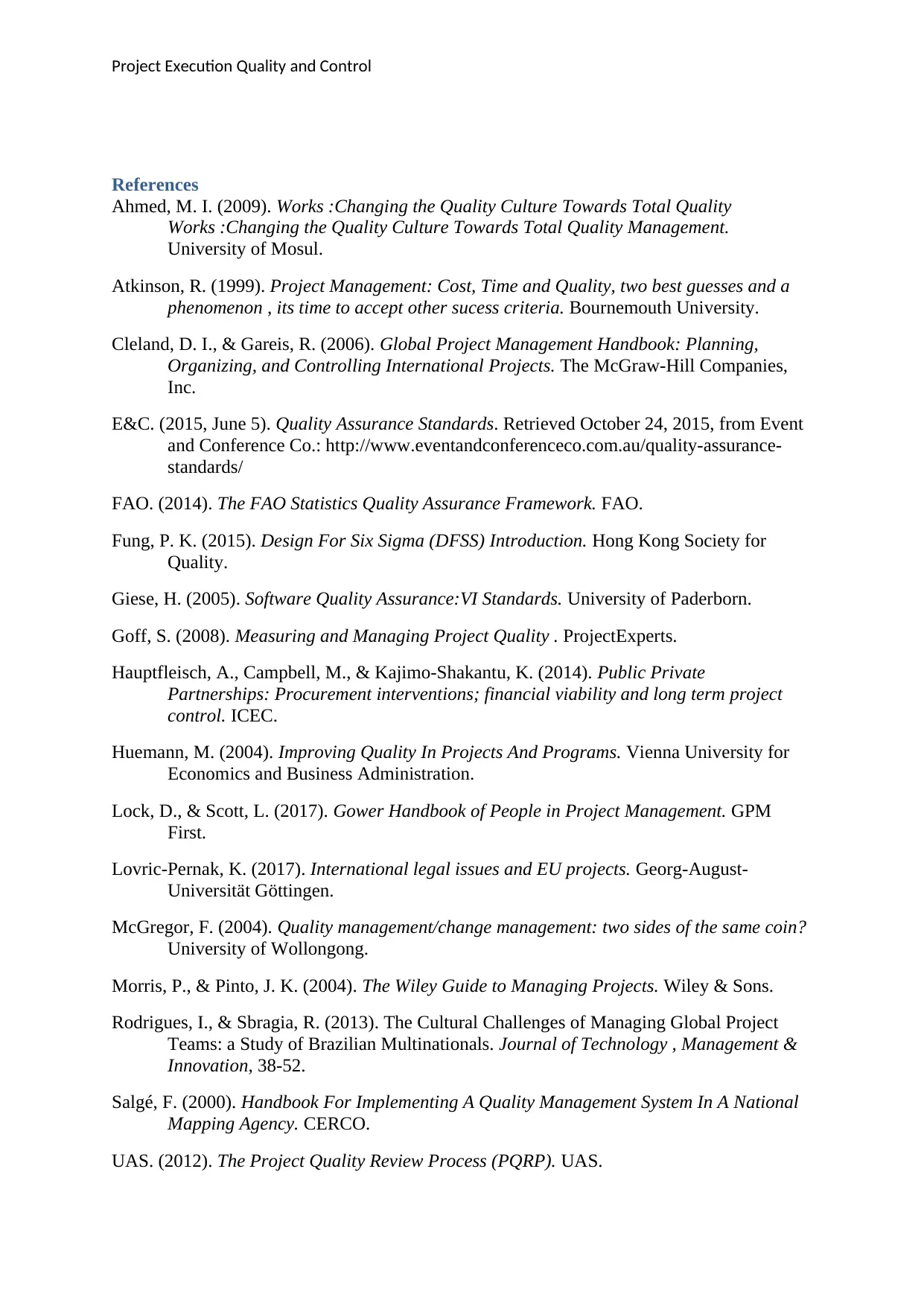
Project Execution Quality and Control
References
Ahmed, M. I. (2009). Works :Changing the Quality Culture Towards Total Quality
Works :Changing the Quality Culture Towards Total Quality Management.
University of Mosul.
Atkinson, R. (1999). Project Management: Cost, Time and Quality, two best guesses and a
phenomenon , its time to accept other sucess criteria. Bournemouth University.
Cleland, D. I., & Gareis, R. (2006). Global Project Management Handbook: Planning,
Organizing, and Controlling International Projects. The McGraw-Hill Companies,
Inc.
E&C. (2015, June 5). Quality Assurance Standards. Retrieved October 24, 2015, from Event
and Conference Co.: http://www.eventandconferenceco.com.au/quality-assurance-
standards/
FAO. (2014). The FAO Statistics Quality Assurance Framework. FAO.
Fung, P. K. (2015). Design For Six Sigma (DFSS) Introduction. Hong Kong Society for
Quality.
Giese, H. (2005). Software Quality Assurance:VI Standards. University of Paderborn.
Goff, S. (2008). Measuring and Managing Project Quality . ProjectExperts.
Hauptfleisch, A., Campbell, M., & Kajimo-Shakantu, K. (2014). Public Private
Partnerships: Procurement interventions; financial viability and long term project
control. ICEC.
Huemann, M. (2004). Improving Quality In Projects And Programs. Vienna University for
Economics and Business Administration.
Lock, D., & Scott, L. (2017). Gower Handbook of People in Project Management. GPM
First.
Lovric-Pernak, K. (2017). International legal issues and EU projects. Georg-August-
Universität Göttingen.
McGregor, F. (2004). Quality management/change management: two sides of the same coin?
University of Wollongong.
Morris, P., & Pinto, J. K. (2004). The Wiley Guide to Managing Projects. Wiley & Sons.
Rodrigues, I., & Sbragia, R. (2013). The Cultural Challenges of Managing Global Project
Teams: a Study of Brazilian Multinationals. Journal of Technology , Management &
Innovation, 38-52.
Salgé, F. (2000). Handbook For Implementing A Quality Management System In A National
Mapping Agency. CERCO.
UAS. (2012). The Project Quality Review Process (PQRP). UAS.
References
Ahmed, M. I. (2009). Works :Changing the Quality Culture Towards Total Quality
Works :Changing the Quality Culture Towards Total Quality Management.
University of Mosul.
Atkinson, R. (1999). Project Management: Cost, Time and Quality, two best guesses and a
phenomenon , its time to accept other sucess criteria. Bournemouth University.
Cleland, D. I., & Gareis, R. (2006). Global Project Management Handbook: Planning,
Organizing, and Controlling International Projects. The McGraw-Hill Companies,
Inc.
E&C. (2015, June 5). Quality Assurance Standards. Retrieved October 24, 2015, from Event
and Conference Co.: http://www.eventandconferenceco.com.au/quality-assurance-
standards/
FAO. (2014). The FAO Statistics Quality Assurance Framework. FAO.
Fung, P. K. (2015). Design For Six Sigma (DFSS) Introduction. Hong Kong Society for
Quality.
Giese, H. (2005). Software Quality Assurance:VI Standards. University of Paderborn.
Goff, S. (2008). Measuring and Managing Project Quality . ProjectExperts.
Hauptfleisch, A., Campbell, M., & Kajimo-Shakantu, K. (2014). Public Private
Partnerships: Procurement interventions; financial viability and long term project
control. ICEC.
Huemann, M. (2004). Improving Quality In Projects And Programs. Vienna University for
Economics and Business Administration.
Lock, D., & Scott, L. (2017). Gower Handbook of People in Project Management. GPM
First.
Lovric-Pernak, K. (2017). International legal issues and EU projects. Georg-August-
Universität Göttingen.
McGregor, F. (2004). Quality management/change management: two sides of the same coin?
University of Wollongong.
Morris, P., & Pinto, J. K. (2004). The Wiley Guide to Managing Projects. Wiley & Sons.
Rodrigues, I., & Sbragia, R. (2013). The Cultural Challenges of Managing Global Project
Teams: a Study of Brazilian Multinationals. Journal of Technology , Management &
Innovation, 38-52.
Salgé, F. (2000). Handbook For Implementing A Quality Management System In A National
Mapping Agency. CERCO.
UAS. (2012). The Project Quality Review Process (PQRP). UAS.
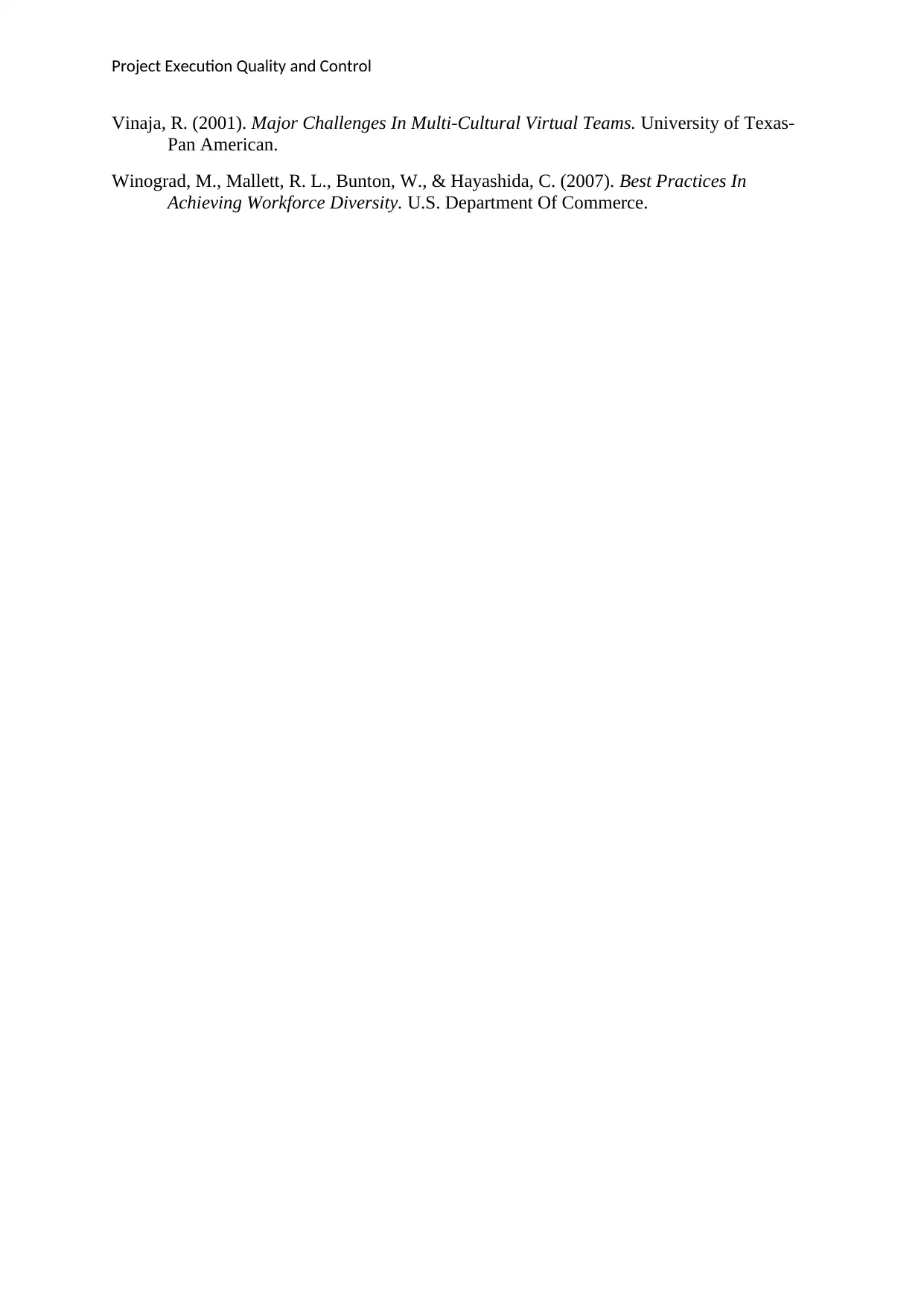
Project Execution Quality and Control
Vinaja, R. (2001). Major Challenges In Multi-Cultural Virtual Teams. University of Texas-
Pan American.
Winograd, M., Mallett, R. L., Bunton, W., & Hayashida, C. (2007). Best Practices In
Achieving Workforce Diversity. U.S. Department Of Commerce.
Vinaja, R. (2001). Major Challenges In Multi-Cultural Virtual Teams. University of Texas-
Pan American.
Winograd, M., Mallett, R. L., Bunton, W., & Hayashida, C. (2007). Best Practices In
Achieving Workforce Diversity. U.S. Department Of Commerce.
⊘ This is a preview!⊘
Do you want full access?
Subscribe today to unlock all pages.

Trusted by 1+ million students worldwide
1 out of 9
Related Documents
Your All-in-One AI-Powered Toolkit for Academic Success.
+13062052269
info@desklib.com
Available 24*7 on WhatsApp / Email
![[object Object]](/_next/static/media/star-bottom.7253800d.svg)
Unlock your academic potential
Copyright © 2020–2025 A2Z Services. All Rights Reserved. Developed and managed by ZUCOL.





